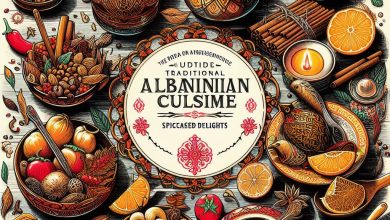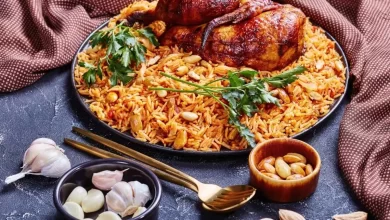“A Culinary Journey Through Albania: Exploring the Rich Tapestry of Albanian Cuisine”
Exploring the Rich Tapestry of Albanian Cuisine
Introduction:
Albania’s rich history, many cultural influences, and geographical diversity are all reflected in the cuisine, which offers a wide variety of tasty meals. Albania, a country tucked away in the Balkans, has a rich culinary legacy that combines Ottoman, Mediterranean, and Balkan cuisines. This essay takes you on a culinary tour around the colorful and varied world of Albanian cuisine, highlighting the distinctive ingredients, age-old cooking techniques, and cultural importance of the nation’s culinary customs.
- Traditional Albanian Staples:
Albanian cuisine is centered around basic ingredients that have been used for generations. Many meals include corn, wheat, dairy products, and a range of fresh vegetables as main ingredients. Bread is a common side dish for most meals, notably the traditional “qullë,” which is flat and circular.
- Byrek – The Queen of Albanian Pies:
A delectable pie created with thin layers of dough, byrek is a representation of Albanian hospitality as well as a culinary masterwork. There are several options for the filling, such as feta cheese, spinach, minced beef, or pumpkin. The layers have a deliciously crunchy feel because they are carefully packed.
- Tavë Kosi – Albania’s National Dish:
The baked lamb and yogurt dish known as tavë Kosi is particularly beloved in Albania. This recipe is a savory and creamy delicacy that mixes delicate lamb, rice, and a large quantity of yogurt. Tavë Kosi highlights the pastoral heritage of the nation and the copious amounts of dairy seen in Albanian cuisine.
- Fërgesë – A Peasant Dish Turned Gourmet:
Fërgesë, a simple yet filling dish prepared with peppers, tomatoes, cottage cheese, and beef, comes from the hilly areas. From its modest beginnings as a peasant lunch, this dish has developed into a treasured culinary creation that symbolizes the Albanian people’s ingenuity and tenacity.
- Pite – Sweet and Savory Pies:
Pite is a multipurpose pie that may be made sweet or savory. Savory variations could contain cheese, pumpkin, or leeks; sweet variants are often composed of layers of phyllo dough filled with almonds, honey, and spices. Pite is a staple of family get-togethers and festivities in Albania.


- Grilled Meats and Kebabs:
In Albanian cuisine, grilled meats—particularly lamb and beef—have a unique position. Kebabs, also known as “qebapa,” are little seasoned beef patties that are typically served with onions, flatbread, and a sauce known as “tavë kosi sauce,” which is made with red pepper. Preferred cooking technique is grilling, which reflects the communal and outdoor nature of Albanian meals.
- Seafood Delicacies:
Albania’s extensive coastline offers a wealth of fresh fish, which has an impact on coastal cuisine. The blend of tastes from the Adriatic and Ionian Seas is shown in dishes like “të ngjellë,” a traditional fish stew. Popular seaside foods include salted fish, fried calamari, and grilled octopus.
- Desserts and Sweets:
Desserts in Albania are a celebration of sweetness, frequently include fruits, nuts, and honey. Baklava is a traditional delicious pastry consisting of layers of phyllo dough, honey, and almonds. In addition, two popular sweets consumed during joyful events are “revani” (semolina cake) and “sheqerpare” (sugar biscuits).
- Raki – The Spirit of Albania:
The social fabric of Albania is strongly rooted in the traditional brandy known as raki. This robust liquor, which is made from fermented fruits—especially grapes—is savored during parties and social events. Because it is frequently produced collaboratively, it represents the value of shared experiences in Albanian culture.
- Culinary Diversity Across Regions:
The varied geography of Albania influences regional cuisines. The northern region’s heavy reliance on meat-based cuisine is a result of its hilly topography. While the central plains emphasize agriculture with a concentration on fresh vegetables and grains, coastal districts are known for their abundance of seafood.


Conclusion:
The history, culture, and geography of Albania are all interwoven in the intriguing tapestry that is Albanian food. Every region offers distinct flavors and culinary customs, from the sun-kissed beaches of the south to the rugged vistas of the north. In addition to providing physical nourishment, Albanian cuisine narrates a tale of tenacity, flexibility, and the nation’s unwavering spirit. Albanian food serves as a testament to the value of conserving cultural heritage via the skill of cooking and sharing meals with loved ones as the globe grows increasingly interconnected.




